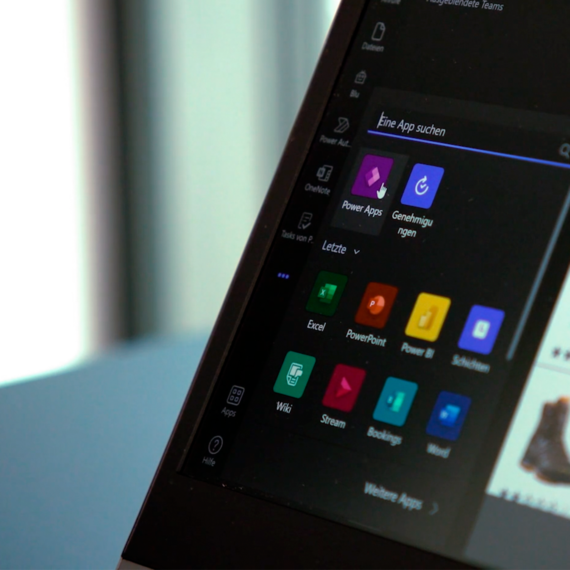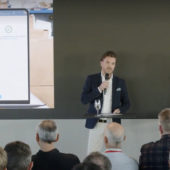Low-code applications simplify and digitise business processes. These applications not only use existing data, but also rely on artificial intelligence. Two real-world Power Platform examples.
In the beginning, there was a problem: if Cablex employees wanted to order new work clothes, they had to select the individual items of clothing from several PDF forms. This was a tedious process with plenty of room for error – incorrect sizes, outdated forms and media disruptions. Michael Stucki, Business Analyst at Cablex, came up with an idea: how about an ordering app to simplify and digitise the process?
Yoann Pernet, Solution Architect at Cablex, also had to deal with lengthy administrative processes. Cablex installers had to invest a considerable amount of time in quality control of the cable installations. And errors could only be identified retrospectively, so specialists had to come back to resolve them. This took up additional time, which was not available for other work.
From idea to Power App
If installers are equipped with an iPad anyway, an app would make quality control easier, thought Yoann Pernet. And he set about developing one of these apps, initially in his free time, using Microsoft’s Power Platform. ‘I was a programmer, UX designer and data architect all in one,’ says Yoann Pernet.
Michael Stucki’s app also simplifies the work of the field service. The app not only automates the ordering process for work clothes, including the necessary approvals, but also reduces returns. Employees can rate and comment on the clothes via the app – just like in a typical online shop. ‘This feedback helps Purchasing and Logistics to better tailor clothing procurement to needs,’ says Michael Stucki.
Acceptance requires rethinking
The two Power Apps simplify processes and save time. A good half an hour for cable installers – and much more if errors can be corrected immediately after the work has been completed. But it turned out that apps don’t automatically meet with acceptance when familiar processes are changed. ‘The initial reactions were mixed,’ recalls Michael Stucki. He first had to persuade people – cultural change management, so to speak. However, this enabled him to create the necessary level of acceptance for the app to be used throughout the company today.
Yoann Pernet also met with some scepticism before his app became an official project. ‘I developed a dashboard with Power BI, which always provides management with up-to-date evaluations. This provided added value to managers and impressed them,’ recalls Yoann Pernet with a smile.
Also read:

How low code enables digital transformation for everyone
Data is scattered across different applications. Processes and repetitive tasks keep on requiring manual work. The error rate increases, and so does employee frustration. Low…
In order to involve the users, the installers, Yoann Pernet relied on close collaboration. He decided to take an agile approach and regularly gathered feedback. Based on this feedback, he continued to develop the app and added new features that really brought benefits.
‘Over time, users have noticed that their feedback flows directly into the app,’ says Yoann Pernet. ‘This allowed me to build trust and overcome people’s reservations.’ This has been a successful approach: initially, only one team used the app as a pilot. It is now widely used. Yoann Pernet’s feedback culture laid the foundation for trust and acceptance of the app. The result is that quality controls are now more efficient and time saved has increased considerably.
Artificial intelligence finds mistakes
Yoann Pernet will hand over his app to another team in order to dedicate himself to new low-code applications. Yoann Pernet and Michael Stucki are convinced that employees who show their own initiative are necessary for such projects. ‘We need early adopters who like to implement projects like this,’ says Yoann Pernet. ‘Power Platform shows that IT doesn’t have to be complicated and that even non-professionals can implement ideas.’ For this to succeed, however, the framework conditions for these ‘citizen developers’ need to be right. This means that they can invest working hours on their projects and, if necessary, call on professional support.
Yoann Pernet learnt how far this commitment can lead when he presented his app. During the presentation, someone suggested adding AI-based image recognition. This would allow installation errors to be detected and corrected immediately on the basis of the photos on site, without the experts having to step out a second time.
Yoann Pernet was given two months to connect the cloud solution for image analysis to Power Platform. Power Platform can use connectors to access the interfaces of other (cloud) applications. ‘I developed a prototype of the connector within six weeks,’ says Yoann Pernet. This shows that low code can certainly mean ‘high power.’
How to get started with Power Platform
Would you like to benefit from an increase in efficiency in your company and are looking for a suitable introduction to the Microsoft Power Platform? Benefit from our advice and our comprehensive know-how.



